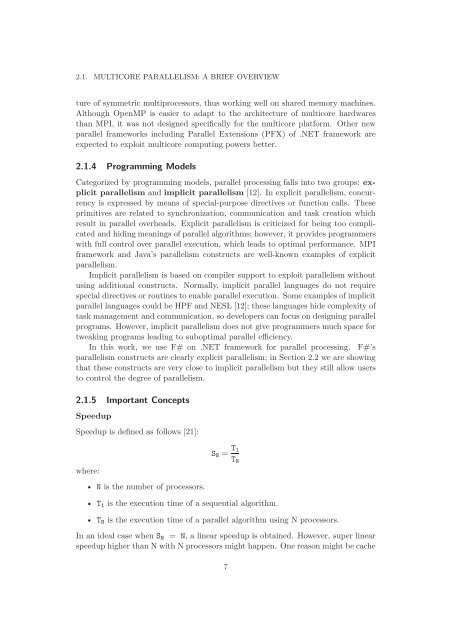Presburger Arithmetic and Its Use in Verification
Presburger Arithmetic and Its Use in Verification
Presburger Arithmetic and Its Use in Verification
Create successful ePaper yourself
Turn your PDF publications into a flip-book with our unique Google optimized e-Paper software.
2.1. MULTICORE PARALLELISM: A BRIEF OVERVIEW<br />
ture of symmetric multiprocessors, thus work<strong>in</strong>g well on shared memory mach<strong>in</strong>es.<br />
Although OpenMP is easier to adapt to the architecture of multicore hardwares<br />
than MPI, it was not designed specifically for the multicore platform. Other new<br />
parallel frameworks <strong>in</strong>clud<strong>in</strong>g Parallel Extensions (PFX) of .NET framework are<br />
expected to exploit multicore comput<strong>in</strong>g powers better.<br />
2.1.4 Programm<strong>in</strong>g Models<br />
Categorized by programm<strong>in</strong>g models, parallel process<strong>in</strong>g falls <strong>in</strong>to two groups: explicit<br />
parallelism <strong>and</strong> implicit parallelism [12]. In explicit parallelism, concurrency<br />
is expressed by means of special-purpose directives or function calls. These<br />
primitives are related to synchronization, communication <strong>and</strong> task creation which<br />
result <strong>in</strong> parallel overheads. Explicit parallelism is criticized for be<strong>in</strong>g too complicated<br />
<strong>and</strong> hid<strong>in</strong>g mean<strong>in</strong>gs of parallel algorithms; however, it provides programmers<br />
with full control over parallel execution, which leads to optimal performance. MPI<br />
framework <strong>and</strong> Java’s parallelism constructs are well-known examples of explicit<br />
parallelism.<br />
Implicit parallelism is based on compiler support to exploit parallelism without<br />
us<strong>in</strong>g additional constructs. Normally, implicit parallel languages do not require<br />
special directives or rout<strong>in</strong>es to enable parallel execution. Some examples of implicit<br />
parallel languages could be HPF <strong>and</strong> NESL [12]; these languages hide complexity of<br />
task management <strong>and</strong> communication, so developers can focus on design<strong>in</strong>g parallel<br />
programs. However, implicit parallelism does not give programmers much space for<br />
tweak<strong>in</strong>g programs lead<strong>in</strong>g to suboptimal parallel efficiency.<br />
In this work, we use F# on .NET framework for parallel process<strong>in</strong>g. F#’s<br />
parallelism constructs are clearly explicit parallelism; <strong>in</strong> Section 2.2 we are show<strong>in</strong>g<br />
that these constructs are very close to implicit parallelism but they still allow users<br />
to control the degree of parallelism.<br />
2.1.5 Important Concepts<br />
Speedup<br />
Speedup is def<strong>in</strong>ed as follows [21]:<br />
where:<br />
• N is the number of processors.<br />
S N = T 1<br />
T N<br />
• T 1 is the execution time of a sequential algorithm.<br />
• T N is the execution time of a parallel algorithm us<strong>in</strong>g N processors.<br />
In an ideal case when S N = N, al<strong>in</strong>earspeedupisobta<strong>in</strong>ed.However,superl<strong>in</strong>ear<br />
speedup higher than N with N processors might happen. One reason might be cache<br />
7
















